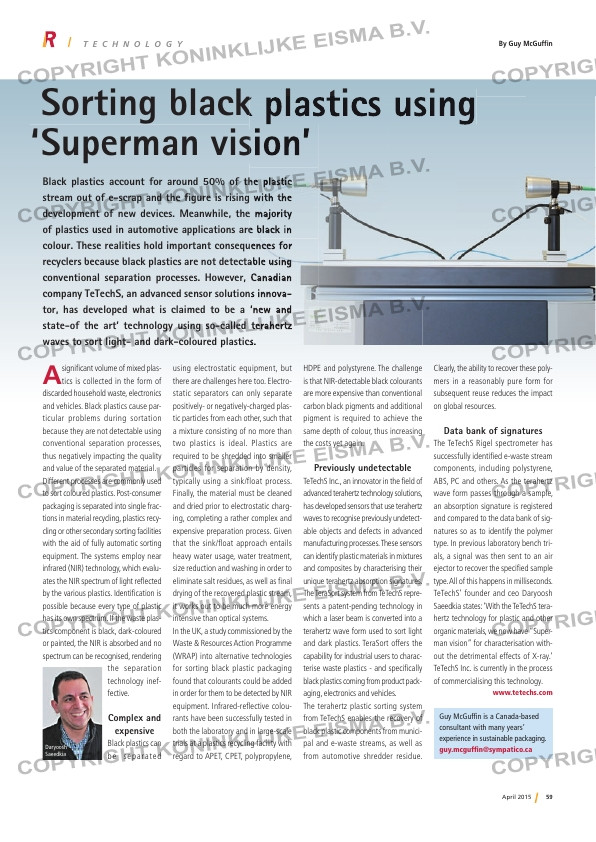Page 59 from: April 2015

59April 2015
Sorting black plastics using
‘ Superman vision’
A signifi cant volume of mixed plas-tics is collected in the form of
discarded household waste, electronics
and vehicles. Black plastics cause par-
ticular problems during sortation
because they are not detectable using
conventional separation processes,
thus negatively impacting the quality
and value of the separated material.
Different processes are commonly used
to sort coloured plastics. Post-consumer
packaging is separated into single frac-
tions in material recycling, plastics recy-
cling or other secondary sorting facilities
with the aid of fully automatic sorting
equipment. The systems employ near
infrared (NIR) technology, which evalu-
ates the NIR spectrum of light refl ected
by the various plastics. Identifi cation is
possible because every type of plastic
has its own spectrum. If the waste plas-
tics component is black, dark-coloured
or painted, the NIR is absorbed and no
spectrum can be recognised, rendering
the separation
technology inef-
fective.
Complex and
expensive
Black plastics can
be separated
using electrostatic equipment, but
there are challenges here too. Electro-
static separators can only separate
positively- or negatively-charged plas-
tic particles from each other, such that
a mixture consisting of no more than
two plastics is ideal. Plastics are
required to be shredded into smaller
particles for separation by density,
typically using a sink/float process.
Finally, the material must be cleaned
and dried prior to electrostatic charg-
ing, completing a rather complex and
expensive preparation process. Given
that the sink/fl oat approach entails
heavy water usage, water treatment,
size reduction and washing in order to
eliminate salt residues, as well as fi nal
drying of the recovered plastic stream,
it works out to be much more energy
intensive than optical systems.
In the UK, a study commissioned by the
Waste & Resources Action Programme
(WRAP) into alternative technologies
for sorting black plastic packaging
found that colourants could be added
in order for them to be detected by NIR
equipment. Infrared-refl ective colou-
rants have been successfully tested in
both the laboratory and in large-scale
trials at a plastics recycling facility with
regard to APET, CPET, polypropylene,
HDPE and polystyrene. The challenge
is that NIR-detectable black colourants
are more expensive than conventional
carbon black pigments and additional
pigment is required to achieve the
same depth of colour, thus increasing
the costs yet again.
Previously undetectable
TeTechS Inc., an innovator in the fi eld of
advanced terahertz technology solutions,
has developed sensors that use terahertz
waves to recognise previously undetect-
able objects and defects in advanced
manufacturing processes. These sensors
can identify plastic materials in mixtures
and composites by characterising their
unique terahertz absorption signatures.
The TeraSort system from TeTechS repre-
sents a patent-pending technology in
which a laser beam is converted into a
terahertz wave form used to sort light
and dark plastics. TeraSort offers the
capability for industrial users to charac-
terise waste plastics – and specifi cally
black plastics coming from product pack-
aging, electronics and vehicles.
The terahertz plastic sorting system
from TeTechS enables the recovery of
black plastic components from munici-
pal and e-waste streams, as well as
from automotive shredder residue.
Clearly, the ability to recover these poly-
mers in a reasonably pure form for
subsequent reuse reduces the impact
on global resources.
Data bank of signatures
The TeTechS Rigel spectrometer has
successfully identifi ed e-waste stream
components, including polystyrene,
ABS, PC and others. As the terahertz
wave form passes through a sample,
an absorption signature is registered
and compared to the data bank of sig-
natures so as to identify the polymer
type. In previous laboratory bench tri-
als, a signal was then sent to an air
ejector to recover the specifi ed sample
type. All of this happens in milliseconds.
TeTechS’ founder and ceo Daryoosh
Saeedkia states: ‘With the TeTechS tera-
hertz technology for plastic and other
organic materials, we now have “Super-
man vision” for characterisation with-
out the detrimental effects of X-ray.’
TeTechS Inc. is currently in the process
of commercialising this technology.
www.tetechs.com
T E C H N O L O G Y By Guy McGuffin
Guy McGuffi n is a Canada-based
consultant with many years’
experience in sustainable packaging.
guy.mcguffi [email protected]
Saeedkia
Black plastics account for around 50% of the plastic
stream out of e-scrap and the figure is rising with the
development of new devices. Meanwhile, the majority
of plastics used in automotive applications are black in
colour. These realities hold important consequences for
recyclers because black plastics are not detectable using
conventional separation processes. However, Canadian
company TeTechS, an advanced sensor solutions innova-
tor, has developed what is claimed to be a ‘new and
state-of the art’ technology using so-called terahertz
waves to sort light- and dark-coloured plastics.



